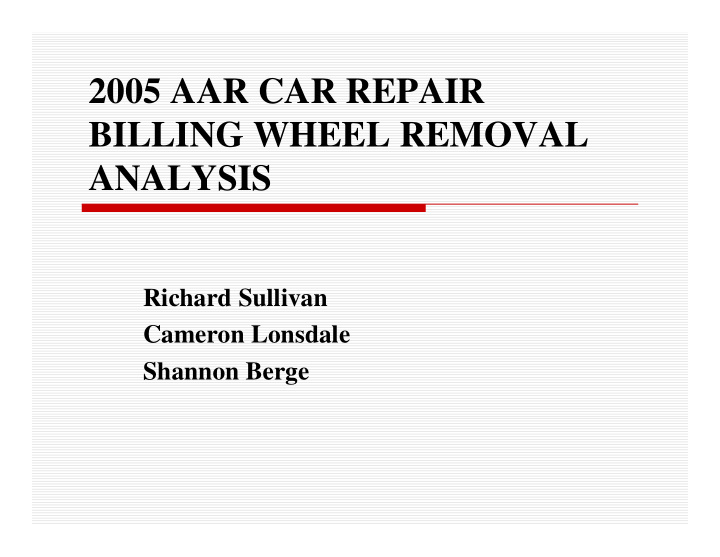



2005 AAR CAR REPAIR BILLING WHEEL REMOVAL ANALYSIS Richard Sullivan Cameron Lonsdale Shannon Berge
RWMEC Who we are Approved AAR Wheel Manufacturers Mission - Support the WABL Committee and the Railroad Industry
7 Year Trend for Wheel Removals 800000 700000 600000 500000 500000 400000 300000 200000 100000 0 1999 2000 2001 2002 2003 2004 2005
Reasons for Increase � A. Increase in Traffic � B. Change in Rules for Condemning Axles � C. Increase in Usage of Why Made Code 65
2004 Effect of High Impact Usage 100000 90000 80000 Out of Round 70000 Thermal Cracks 60000 Tread Shell 50000 Slit Flat 40000 High Impact 30000 20000 10000 0 1999 2000 2001 2002 2003 2004
2005 Effect of High Impact Usage 120000 100000 Out of Round 80000 Thermal Cracks Thermal Cracks 60000 Tread Shell Slit Flat 40000 High Impact 20000 0 1999 2000 2001 2002 2003 2004 2005
7 Year Trend for Thin Flange and High Flange 70000 60000 50000 40000 40000 60 Thin Flange 64 High Flange 30000 20000 10000 0 1999 2000 2001 2002 2003 2004 2005
WHEEL REMOVAL CATEGORIES Categories Administrative Administrative Wear Related Environment Wheel Failure 0 50000 100000 150000 20000 25000 30000 35000 40000 45000 0 0 0 0 0 0
Administrative Administrative Wheels 07 Obsolete 11 Good Condition 23 Govt. Reg. 25 Owner's Req. 90 Mate Wheel 0 100000 200000 300000 400000
Unusual Trends � Why Made Code 11 Removals have increased 175,000 during the past three years.
7 Year Trend – Administrative Wheels Administrative Wheels 450,000 450,000 400,000 350,000 300,000 250,000 200,000 1999 2000 2001 2002 2003 2004 2005
Wear Related Wear Related Wheels 60=Thin Flange 64=High Flange 73=Thin Rim 98=Reapplication 0 20000 40000 60000 80000
7 Year Trend – Wear Related Wheels Wear Related Wheels 120,000 100,000 80,000 60,000 1999 2000 2001 2002 2003 2004 2005
Environmental Environmental Wheels 65 High Impact 67=Out-of-Round 74=Thermal Cracks 75=Tread Shelled 76=Tread Build-Up 78=Tread Slid Flat 0 20000 40000 60000 80000 100000 120000
7 Year Trend- Environmental Wheels Environmental Wheels 200,000 150,000 100,000 50,000 1999 2000 2001 2002 2003 2004 2005
Spalling Spalling � Spalling starts when a thin localized layer of tread metal is transformed to martensite. The martensite, being very hard and brittle, forms cracks that propagate into the non- cracks that propagate into the non- transformed material. These cracks turn and grow in fatigue roughly parallel to the tread. When these cracks link together material vacates the tread leaving a pitted surface.
���������������������������
Failed Wheels Failed Wheels 66=Flange Cracked 68=Rim Cracked 71=Rim Shattered 72=Rim Spread 0 100 200 300 400
7 Year Trend – Failed Wheels Failed Wheels 1,200 1,100 1,000 900 800 700 600 1999 2000 2001 2002 2003 2004 2005
26-Year Trend Shell/Spall Wheels Tread Shelled (Spalled) Wheels 100000 80000 80000 60000 40000 20000 0 1980 1982 1984 1986 1988 1990 1992 1994 1996 1998 2000 2002 2004
Distribution of Failed Wheels by Year Failed Wheel Distribution 100 80 80 60 40 20 0 1 0 4 8 2 6 0 4 8 2 6 7 7 7 8 8 9 9 9 0 9 9 9 9 9 9 9 9 9 0 1 1 1 1 1 1 1 1 1 2
Wheel Removals by Year Manufactured Year Built Distribution 80000 60000 40000 20000 0 1959 1965 1971 1977 1983 1989 1995 2001
Average Wheel Life/Category � Administrative 9.8 Years � Wear Related 11.0 Years � Environmental 8.8 Years � Wheel Failure 12.2 Years
Average Wheel Life/Car Type � Type of Car Wheel Life, Years � Box 12.5 � Gondola 8.5 � Hopper � Hopper 9.5 9.5 � Covered Hopper 12.6 � Tank 12.5 � Flat 7.8 � Articulated 4.5
Wheel Removals by Year Manufactured Year Built Distribution 80000 60000 40000 20000 0 1959 1965 1971 1977 1983 1989 1995 2001
Distribution of Wheel Types Wheel Type HT-CP NHT-CP HT-SP NHT-SP AAR Raw 91.7% 5.7% .7% 1.8% AAR Accel. 92.1% 6.2% 0. 6% 1.1%
Distribution of SP Wheels SP Wheel By Car Type Tank Cars Co vered Ho pper Cars Co vered Ho pper Cars Ho pper Cars Go ndo las Flat Cars Bo x Cars 0 1000 2000 3000 4000 5000 6000
RWMEC Recommendations � Already Implemented � Accelerate removal of straight plate wheels � Proposal to accelerate earlier removal of Non- Heat Treated Curve Plate Wheels Heat Treated Curve Plate Wheels � Improving their wheel marking procedures
RWMEC Recommendations � Improve air brake testing methods. � Train employees about the proper use of hand brakes.
Comparisons � Removals for high impact are more common for 36-inch and 38-inch wheels. � 36-inch wheels have a higher percentage of wheels removed for slid flat, thin flange, built- wheels removed for slid flat, thin flange, built- up-tread and out-of-round.
Comparisons � Articulated cars have many unique characteristics. � The wheels wear out faster. � They have the most wheels removed for High Flange.
Comparisons � Covered Hopper Cars have the most wheels for all causes. � Tank cars and covered hopper cars have the most wheel removals for Why Made Code 78, most wheel removals for Why Made Code 78, Slid Flat.
Comparisons � The primary reasons for wheel removals from flat cars: � Why Made 64, High Flange � Why Made 65, High Impact � Why Made 65, High Impact � Why Made 75, Tread shelled
Comparisons � Tank cars have the second highest wheel removals for Why Made 74, Thermal Cracks.
Comparisons � Gondolas, Hoppers and Box Cars have a similar pattern. The most frequent causes for removal for these car types are: � Why Made 65, High Impact � Why Made 65, High Impact � Why Made 64, High Flange � Why Made 60, Thin Flange
Thanks � RWMEC thanks the AAR for providing 2005 wheel repair data for this analysis and report. � RWMEC thanks the Railway Supply Institute and MARTS for the opportunity to present this and MARTS for the opportunity to present this information at the 2006 RSI conference.
Questions
Recommend
More recommend